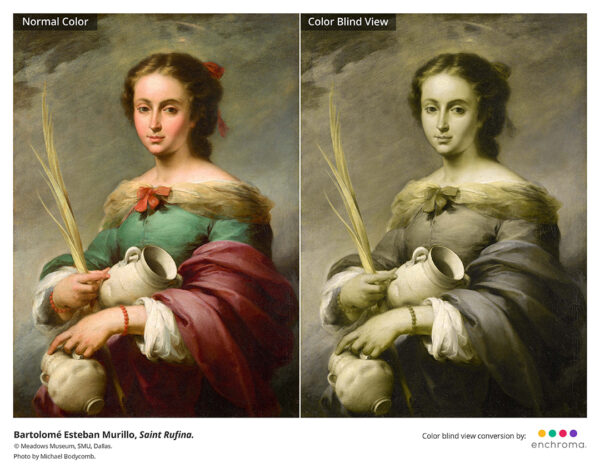The Meadows Museum at Southern Methodist University in Dallas is the first museum in Texas to provide visitors with glasses designed to assist people who are color blind.
From specialized programming to interpretative materials, for decades museums have made efforts to increase accessibility for visitors of all ages, backgrounds, and abilities. The Meadows already provides tactile graphics (raised line drawings of works of art in the collection), family activity kits in Braille, magnifying devices, and multimodal tours. Now available for check out free of charge, EnChroma glasses allow visitors with color vision deficiencies to experience works of art as originally intended by artists.
In a press release, the museum’s Director ad interim Amanda W. Dotseth said,“It is difficult for most of us to imagine a world of art lacking color—the lush green of a summer landscape, for instance, or a cardinal’s crimson cassock. We are excited to bring this technology to our visitors and hope that it will encourage those who may have cast aside the notion of visiting an art museum because of this condition to try it out.”

Bartolomé Esteban Murillo, “Saint Rufina.” © Meadows Museum, SMU, Dallas. Original photo by Michael Bodycomb. Color blind view conversion by EnChroma.
According to data provided by EnChroma, an estimated 13 million people in the United States have color vision deficiency. This includes 8% of men and .5% of women. People with typical color vision can see over one million shades of color, however, those with red-green color vision deficiency see approximately 10% of visible hues and shades. This results in many colors appearing dull. For example, purples may appear blue, reds may appear brown, and green and yellow may be difficult to distinguish. The glasses now available at the Meadows, patented by EnChroma, use filters that help to separate color channels, which allows colors to appear clearer and more vibrant.

Santiago Rusiñol i Prats, “Cluster of Cypresses, Arbor IV.” © Meadows Museum, SMU, Dallas. Original photo by Kevin Todora. Color blind view conversion by EnChroma.
Erik Ritchie, the CEO of EnChroma stated about the museum’s use of their product, “It is exciting and inspiring that students at Southern Methodist University, and other visitors to the Meadows Museum who are color-blind, will be able to more fully experience the colors in iconic works by masters such as El Greco, Velázquez, Dalí and Picasso with our glasses. We hope that the Meadows Museum’s initiative encourages other museums, universities and organizations to work with us towards inclusion for those with color vision deficiencies.”


